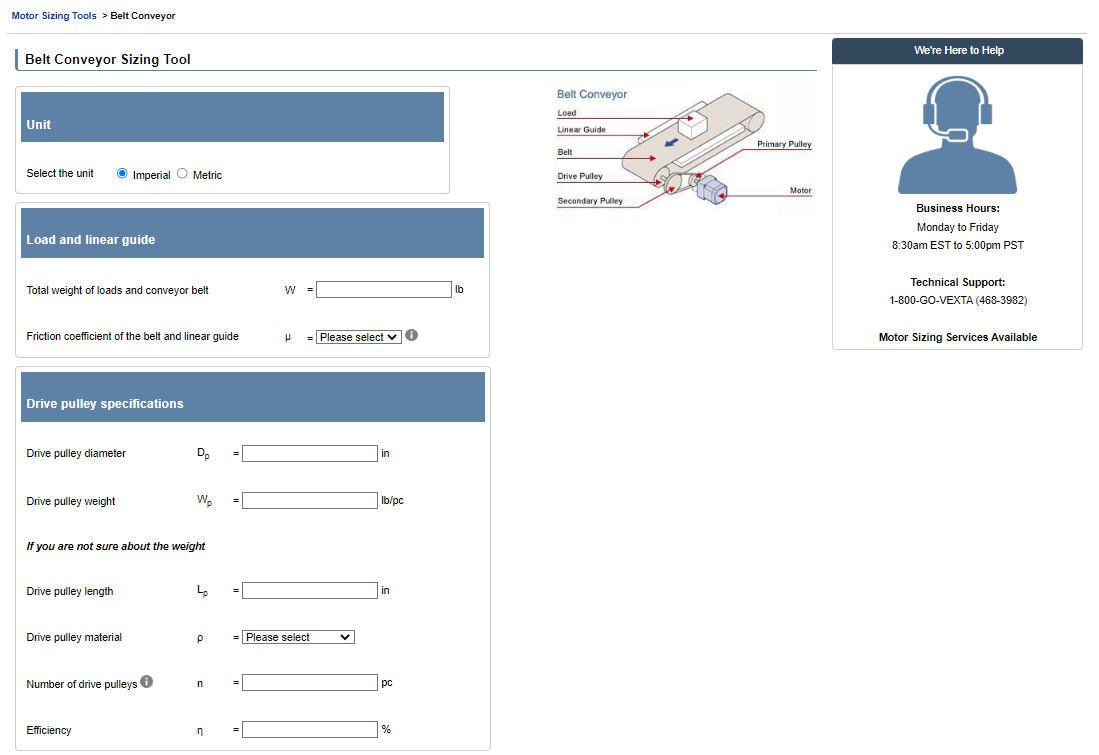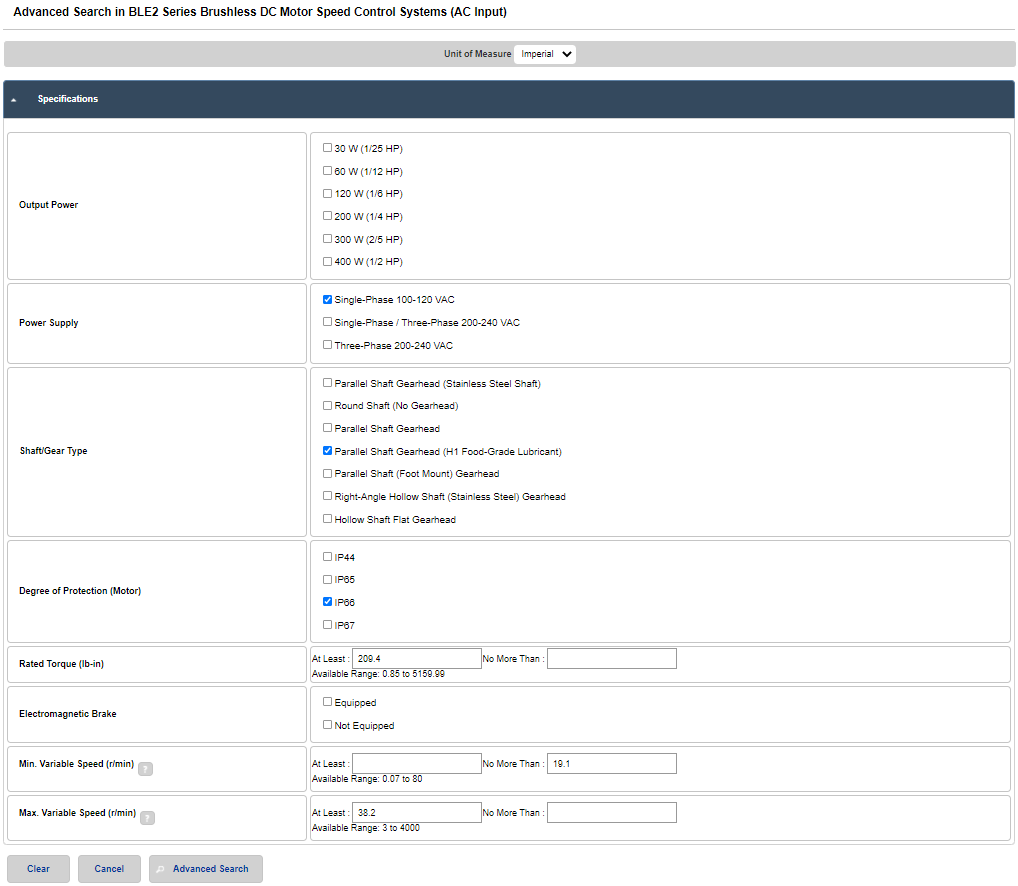Many motor manufacturers offer a motor sizing tool to help with product selection, but if you don't know how to use it, you may still end up paying for it in the long run.
A motor sizing is necessary to calculate the motor's primary requirements for a specific application: torque, speed, and inertia. The next step is product selection, which uses these torque, speed, and inertia values to select a particular size of a motor in order to avoid oversizing or undersizing. This post explains how to use a motor sizing tool to calculate these values, and how to use them to select a motor for a variable speed belt conveyor.
What's covered?
- What is a Variable Speed Belt Conveyor?
- Motor Sizing Example
- Motor Selection Example
- Summary
What is a Variable Speed Belt Conveyor?
Belt conveyors use pulleys and belts to convert rotary motion to linear motion and move a load on its belt. There may be a linear guide to support the load. The motor could be connected to the drive pulley through a combination of a primary and secondary pulley, which adds an external gear ratio. A "variable speed belt conveyor" is a conveyor that can run multiple speeds with different acceleration and deceleration settings.
In order to determine the inertia, speed, and torque required by the motor, a series of calculations is necessary. Many motor manufacturers use some form of a motor sizing calculator where you can simply input values to calculate your results.
| Motor Sizing Example | Variable Speed Belt Conveyor |
In the following sections, I will explain how to use our  for a horizontal belt conveyor that needs to move a load of 100 lbs between 12~24 inches per second.
for a horizontal belt conveyor that needs to move a load of 100 lbs between 12~24 inches per second.
Here's what you see when you start.

Here are the parameters that I need to enter into the motor sizing tool. Remember, the sizing results are only as accurate as the input values, so try not to "guesstimate" too much.
| Parameters | Values |
| Total weight of loads and conveyor belt Friction coefficient of the belt and linear guide Drive pulley diameter Drive pulley weight Total number of pulleys Mechanical efficiency External force External gear ratio Mechanism angle Hold the load even after power is turned off Hold the load only when power is on Required speed Required acceleration/deceleration time Stopping accuracy Safety factor |
100 lbs 0.1 12 inches 1 lb/pc 4 total pulleys 90% 0 lb none 0° No yes 12~24"/sec 1 second 0.25 inches 2 |
First, select the "Unit". This will change the units on the motor sizing tool to imperial or metric. Since I have the load in 100 lbs, I chose "Imperial".

Input the values for "Total weight of loads and conveyor belt" and "Friction coefficient of the belt and linear guide". The belt weight is considered as load as well.

Next, input the "Drive pulley specifications". Make sure to input the correct number of pulleys.

Remember to account for any "External force" or opposing force; such as a spring load.

If you have any external pulleys or gear ratios, please input the information here. If you are directly coupling the motor to the drive pulley without any external pulleys, then leave the fields blank.

Input the "Mechanism angle" of the conveyor in degrees. This conveyor is horizontal, so 0° is input.

List any "Other requirement(s)" you may have, such as electromagnetic brake or electrical holding torque.

Input your "Operating conditions". For variable speed requirements, enter V1 (low speed) and V2 (top speed) in inches per second, then enter your acceleration/deceleration time (t1).

Enter the required "Stopping accuracy". This will convert the linear unit "in" to "degrees". This is more critical for positioning applications, but it's a required field.

Last but not least, enter your "Safety factor". If you aren't completely sure of your parameter values, then use a large safety factor. You always want to leave some room for other factors that might affect the motor requirements. For example, other friction in the system can increase the required torque.

To see your sizing results, please click  at the bottom.
at the bottom.
| FYI |
Choosing different "operating conditions", such as "fixed speed operation", "variable speed operation", or "positioning operation" changes the input fields and calculations to accommodate different types of motors.
For example, here's how the input fields change for "fixed speed operation" and "variable speed operation".
|
Now we have the 3 most important values to determine the best motor size: load inertia, required speeds V1 and V2, and required torque. The required stopping accuracy is also provided as a reference. Click "Full Report" to see the actual calculations, or click "Tips" for motor selection tips.
| Motor Sizing Results | Variable Speed Belt Conveyor |
The motor sizing results are as follows:

We'll need to find a motor that meets these primary requirements. We will skip "Required Stopping Accuracy" and "Other Requirement(s)" for this example.
|
Motor Requirements:
|
The easiest way to find a suitable motor is to use the "Search by Specification" tool for the specific type of motor. However, the "Search by Specification" tool is located on the overview pages for specific types of motors, so you need to select a type of motor first.
Use the  to find motors by specification(s), then input sizing results.
to find motors by specification(s), then input sizing results.
| Motor Selection Example | Variable Speed Belt Conveyor |
Brushless motors' performance, size, and efficiency characteristics, combined with their unique driver functions and a variety of gear options, make them ideal for continuous-duty variable speed conveyors. Here's a guide that introduces the characteristics of all types of motors.
The following example shows how to use the sizing results to find the most suitable brushless motor and driver system.
Once you select the type of motor from our website navigation menu, please "Search by Specification" by using the sizing results you calculated.

Once you click "Search by Specification", then you can search by the following parameters:
- Output power
- Power supply
- Driver type
- Rated torque
- Min. variable speed
- Max. variable speed
- Shaft/gear type
- Gear ratio
- Output shaft type
- Degree of protection (IP rating)
- Electromagnetic brake
Since brushless motors require a driver, the power supply and driver type are for the dedicated driver that is required to control the brushless motor. Oriental Motor is focused on providing a complete solution rather than components.
Here are the parameters I put in for the "Search by Specification". Notice that I only put in the parameters I know: power supply, driver type, torque, min. variable speed, max. variable speed, parallel shaft gearhead with H1 food grade grease, and IP66 rating.

Once you click  , it will list the product(s) that satisfy these requirements.
, it will list the product(s) that satisfy these requirements.

Recommended: [ BLM5120HP-100SF (120 W Gear Motor with 100:1 Gear Ratio) / BLE2D120A (Dedicated Driver) ]
Rated Torque: 260 lb-in ✅ > 209.4 lb-in
Speed Range: 0.8~40 RPM ✅ > 19.1 (V1) ~38.2 (V2) RPM
Load Inertia: 66,000 oz-in² ✅ > 58,752 oz-in²
The motor and driver are from the BLE2 Series, which also offers optional H1 food-grade grease and an IP67 rating. These are ideal for conveyors that can come into contact with food and need periodic washdown.
| Summary |
|
Selecting the wrong product for the job could cause delays in completing your machine build. Knowing how to use a motor sizing tool properly and how to apply the sizing results can speed up the motor selection process. The quality of your motor sizing calculations directly depends on how accurately you measure and specify your application parameters. Precise data about load characteristics, motion profiles, and operating conditions leads to optimal motor selection. Conversely, rough estimates or incomplete specifications can result in undersized or oversized solutions. In addition to satisfying inertia, speed, and torque requirements, a machine designer also needs to consider the required power supply, the motor's IP rating as well as the motor driver's features and functions.
Pick the option that works best for your application (and budget). TIP: the accuracy of the sizing results depends on the accuracy of the application parameters.
|
Prefer to have someone else size your motor? Our experienced  can help!
can help!






